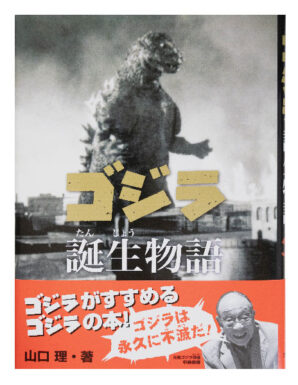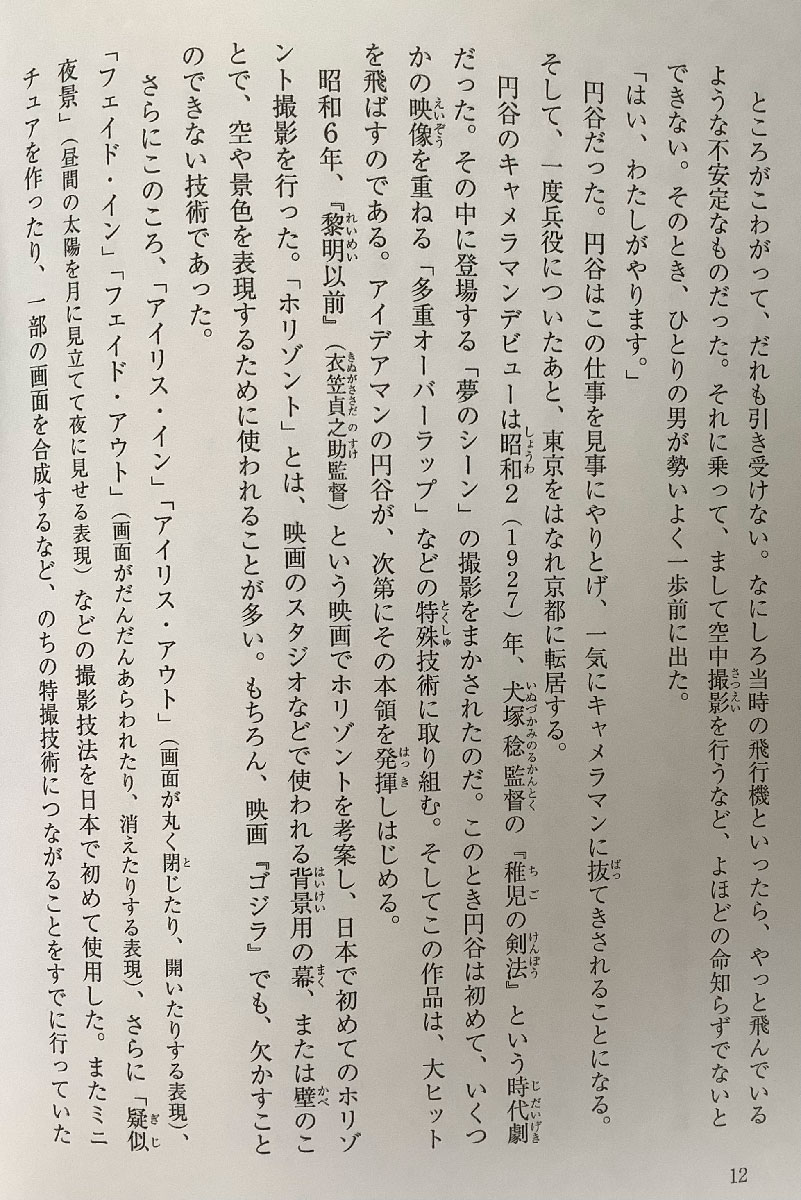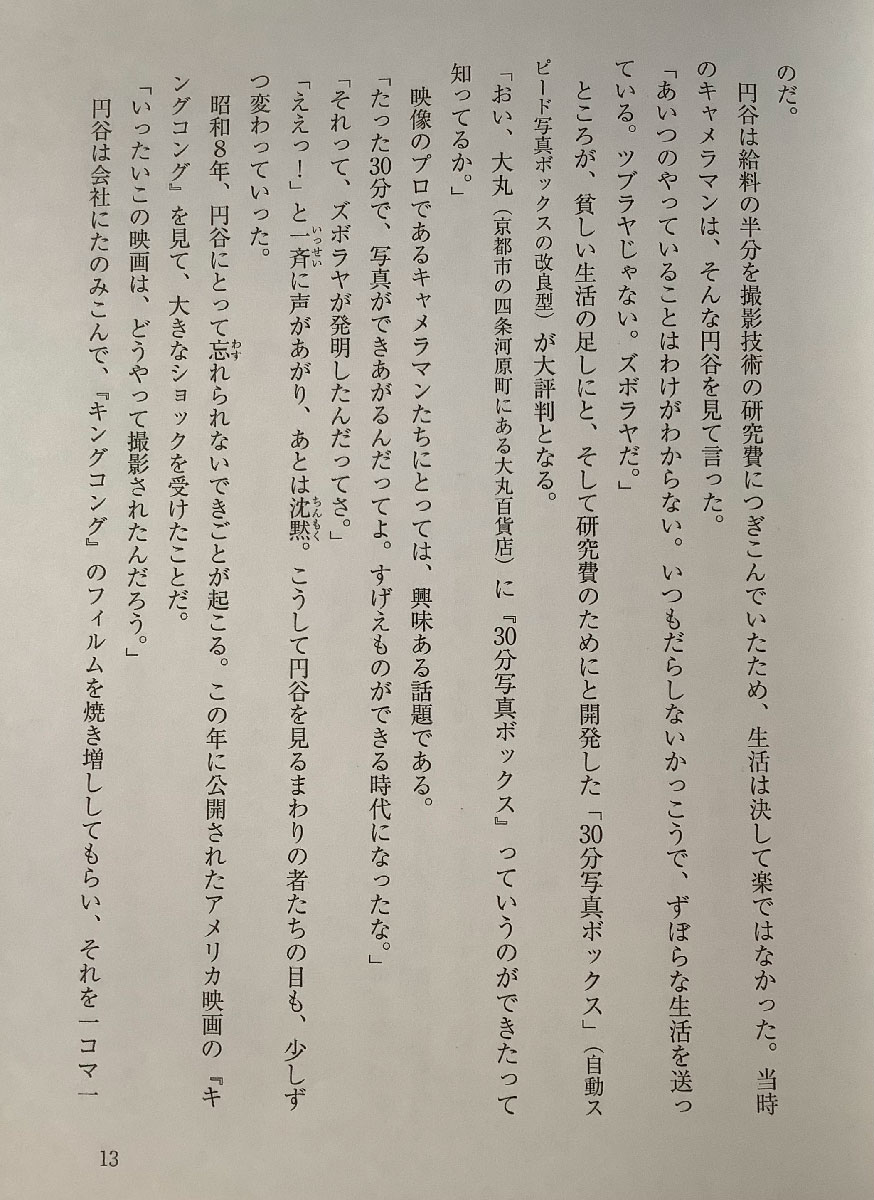6.9.2023
The Story of Godzilla’s Birth – Pt 5


P 12
ところがこわがって、だれも引き受けない。なにしろ当時の飛行機といったら、やっと飛んでいるさつえいような不安定なものだった。それに乗って、まして空中撮影を行うなど、よほどの命知らずでないとできない。そのとき、ひとりの男が勢いよく一歩前に出た。「はい、わたしがやります。」
However, he was frightened and no one accepted. After all, airplanes in those days were so unstable that they were barely flying. Riding on it, let alone shooting in the air, requires a very daredevil. At that moment, a man stepped forward. “Yes, I will.”
円谷だった。円谷はこの仕事を見事にやりとげ、一気にキャメラマンに抜てきされることになる。そして、一度兵役についたあと、東京をはなれ京都に転居する。
It was Tsuburaya. Tsuburaya accomplished this task brilliantly, and was quickly selected as a cameraman. After completing his military service, he left Tokyo and moved to Kyoto.
円谷のキャメラマンデビューは昭和2(1927)年、犬塚稔監督の『稚児の剣法』という時代劇だった。その中に登場する「夢のシーン」の撮影をまかされたのだ。このとき円谷は初めて、いくつとくしゅえいぞうかの映像を重ねる「多重オーバーラップ」などの特殊技術に取り組む。そしてこの作品は、大ヒットはっきを飛ばすのである。アイデアマンの円谷が、次第にその本領を発揮しはじめる。
Tsuburaya made his debut as a cameraman in 1927 with Minoru Inuzuka’s historical drama “Chigo no Kenpo,” in which he was entrusted with the filming of the “dream scene.” At this time, Tsuburaya worked for the first time on special technology such as “multiple overlap,” which overlaps several images. And this work is a big hit. Tsuburaya, an idea man, gradually begins to show his true potential.
昭和6年、『黎明以前』(衣笠貞之助監督)という映画でホリゾントを考案し、日本で初めてのホリゾ「はいけいまくかべント撮影を行った。「ホリゾント」とは、映画のスタジオなどで使われる背景用の幕、または壁のことで、空や景色を表現するために使われることが多い。もちろん、映画『ゴジラ』でも、欠かすことのできない技術であった。
In 1931, he devised the concept of cyclorama in the movie “Before Dawn” (directed by Teinosuke Kinugasa), and filmed Japan’s first Horizont “Haikeimaku Bento.” A background curtain or wall used, often used to represent the sky or scenery. Of course, it was also an indispensable technology in the movie “Godzilla.”
Cyclorama (theater)A cyclorama is a large curtain or wall, often concave, positioned at the back of the stage area. It was popularized in the German theater of the 19th century and continues in common usage today in theaters throughout the world. A “cyc” (US theatrical abbreviation) can be made of unbleached canvas (larger versions) or muslin (smaller versions), filled scrim (popularized on Broadway in the 20th century), or seamless translucent plastic (often referred to as “Opera Plastic”). (Source: Jisho.org)
さらにこのころ、「アイリス・イン」「アイリス・アウト」(画面が丸く閉じたり、開いたりする表現)、「フェイド・イン」「フェイド・アウト」(画面がだんだんあらわれたり、消えたりする表現)、さらに「疑似夜景」(昼間の太陽を月に見立てて夜に見せる表現)などの撮影技法を日本で初めて使用した。またミニチュアを作ったり、一部の画面を合成するなど、のちの特撮技術につながることをすでに行っていたのだ。
Furthermore, around this time, “iris in” and “iris out” (expressions in which the screen closes and opens in a circle), “fade in” and “fade out” (expressions in which the screen gradually appears and disappears), In addition, he was the first in Japan to use photography techniques such as “pseudo nightscape” (an expression that makes the daytime sun look like the moon at night). He also made miniatures and synthesized some screens, which would later lead to special effects techniques.

P 13
円谷は給料の半分を撮影技術の研究費につぎこんでいたため、生活は決して楽ではなかった。当時のキャメラマンは、そんな円谷を見て言った。
Tsuburaya spent half of his salary on filming technology research, so his life was by no means easy. The cameraman at the time saw Tsuburaya and said,
「あいつのやっていることはわけがわからない。いつもだらしないかっこうで、ずぼらな生活を送っている。ツブラヤじゃない。ズボラヤだ。」
“I don’t understand what he’s doing. He’s always scruffy and has a sloppy life. He’s not Tsuburaya. He’s Zuboraya.”
ずぼら “zobora” means “sloppy; slovenly; slipshod; negligent; loose; unkempt” (Source: Jisho.org)
ところが、貧しい生活の足しにと、そして研究費のためにと開発した「30分写真ボックス」(自動スピード写真ボックスの改良型)が大評判となる。
However, the “30-minute photo box” (an improved version of the automatic speed photo box), which was developed to make up for the poor life and for research funds, became very popular.
「おい、大丸(京都市の四条河原町にある大丸百貨店)に「30分写真ボックス』っていうのができたって知ってるか。」
“Hey, did you know that Daimaru (Daimaru Department Store in Shijo Kawaramachi, Kyoto) has a 30-minute photo box?”
映像のプロであるキャメラマンたちにとっては、興味ある話題である。
It is an interesting topic for cameramen who are video professionals.
「たった30分で、写真ができあがるんだってよ。すげえものができる時代になったな。」
“It takes only 30 minutes to create a photo.
「それって、ズボラヤが発明したんだってさ。」
“That’s what Zuboraya invented.”
「ええっ!」と一斉に声があがり、あとは沈黙。こうして円谷を見るまわりの者たちの目も、少しずつ変わっていった。
“Eh!” In this way, the eyes of those around him who looked at Tsuburaya also changed little by little.
昭和8年、円谷にとって忘れられないできごとが起こる。この年に公開されたアメリカ映画の『キングコング』を見て、大きなショックを受けたことだ。
In 1933, an event that Tsuburaya will never forget occurs. He was shocked when he saw the American movie “King Kong” released that year.
「いったいこの映画は、どうやって撮影されたんだろう。」
“How the hell was this movie made?”
円谷は会社にたのみこんで、「キングコング』のフィルムを焼き増ししてもらい、それを一コマーコマ、丹念に分析するといった熱の入れようだった。
Tsuburaya persuaded the company to reprint the “King Kong” film, and it seemed that he was enthusiastic about analyzing it carefully frame by frame.